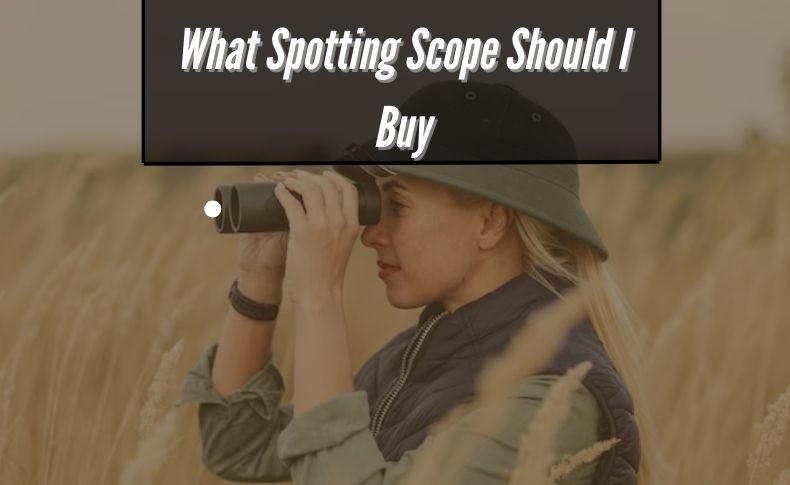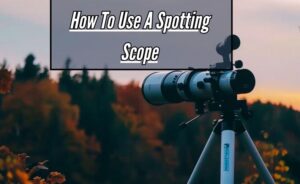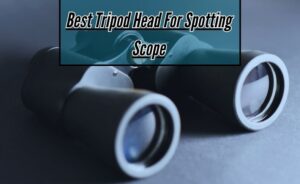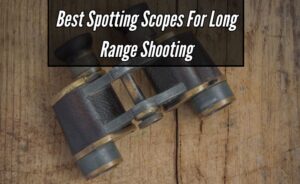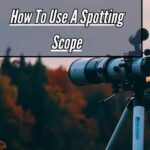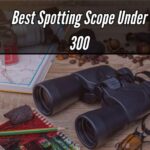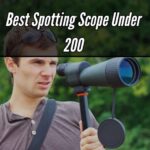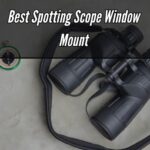Are you contemplating purchasing a spotting scope? It’s not just you! Considering all the options available, selecting the best spotting scope can be a little difficult. But do not worry; we are here to assist you in making the procedure simpler. For outdoor lovers, birdwatchers, hunters, and anyone who appreciates seeing far-off objects up close, a spotting scope is a useful tool.
What Spotting Scope Should I Buy? Consider your unique needs while selecting a spotting scope. Choose a scope with a greater magnification (between 20 and 60x) and a larger objective lens (about 80mm) for better clarity when watching birds or other wildlife. Prioritize attributes like image stabilization and robust construction if you enjoy target shooting. For the best match for your interests and budget, compare models and read user reviews.
It’s similar to having a pocket telescope that enables you to focus on distant details, making it simpler to observe distant objects like stars, wildlife, and landscapes. We’ll break down the important variables to take into account when choosing a spotting scope in this article. We’ll explain the technical lingo and assist you in determining which specs are most crucial for your needs.
Navigating the World of Spotting Scopes: A Comprehensive Buying Guide
Spotting scopes are invaluable tools for nature enthusiasts, birdwatchers, hunters, and outdoor adventurers. Choosing the right spotting scope can enhance your outdoor experiences, but with a multitude of options available, it can be a daunting task.
In this comprehensive buying guide, we’ll break down the key factors to consider when purchasing a spotting scope, making the process more accessible and helping you make an informed decision.
Understanding Spotting Scopes
Before delving into the buying process, it’s essential to understand what a spotting scope is. A spotting scope is a portable, high-magnification telescope designed for terrestrial observation. It’s different from binoculars, offering more powerful magnification, making distant objects appear closer and clearer.
Objective Lens Size Matters
One of the most critical factors in choosing a spotting scope is the objective lens size. This lens determines how much light the scope can gather, impacting image brightness and clarity.
Larger objective lenses (typically between 60mm and 100mm) allow for better performance in low-light conditions and provide sharper images.
Magnification and Zoom Range
Spotting scopes offer variable magnification, usually in the form of a zoom eyepiece. Consider your intended use when selecting magnification. Higher magnification (e.g., 20-60x) is ideal for detailed observations but may require a tripod for stability. Lower magnification (e.g., 15-45x) is better for wider field viewing.
Lens Coatings and Image Quality
Spotting scopes come with various lens coatings that affect image quality. Look for scopes with fully multi-coated lenses, which reduce glare and improve light transmission. This results in sharper and more vibrant images, especially in challenging lighting conditions.
Waterproof and Fogproof Design
If you plan to use your spotting scope outdoors, ensure it has a waterproof and fogproof design. This feature protects the scope from moisture, making it suitable for rain or humid environments. It also prevents internal fogging, ensuring a clear view in changing weather conditions.
Size and Portability
Consider the size and weight of the spotting scope, especially if you’ll be carrying it during outdoor adventures. Compact and lightweight scopes are more convenient for on-the-go use, while larger models may provide better image quality but can be cumbersome to transport.
Eyepiece and Accessories
Lastly, pay attention to the eyepiece design and the availability of compatible accessories. Some spotting scopes allow you to change eyepieces for different magnification options. Additionally, check for features like a retractable sunshade and a rotating tripod collar for added convenience.
Choosing the Right Spotting Scope: Factors to Consider

Spotting scopes are invaluable tools for outdoor enthusiasts, birdwatchers, hunters, and astronomers. They help us zoom in on distant objects with clarity and precision.
However, selecting the right spotting scope can be a daunting task with the plethora of options available. To make an informed choice, consider the following factors:
Objective Lens Size:
One of the primary considerations when choosing a spotting scope is the size of the objective lens. A larger objective lens lets in more light, resulting in brighter and clearer images.
However, it also makes the scope bulkier and heavier. Consider your intended use and portability needs when deciding on the objective lens size.
Magnification:
Spotting scopes come with various magnification options. While high magnification may seem enticing, it can lead to reduced image stability and a narrower field of view.
Opt for a scope with a magnification range that suits your specific needs, ensuring a balance between zoom and stability.
Lens Coatings:
Lens coatings are crucial for image quality. Look for spotting scopes with multi-coated or fully multi-coated lenses. These coatings reduce glare, improve contrast, and enhance light transmission. They are especially beneficial in challenging lighting conditions.
Weather Resistance:
If you plan to use your spotting scope outdoors, consider its weather resistance. A waterproof and fog-proof scope ensures that you can use it in various weather conditions without worrying about moisture damage or fogging of the lenses.
Size and Weight:
The size and weight of your spotting scope can significantly impact your outdoor adventures. If you need a portable scope for hiking or traveling, opt for a compact and lightweight model. However, if you prioritize image quality and don’t mind the extra bulk, a larger scope may be suitable.
Eyepiece Options:
Spotting scopes often allow interchangeable eyepieces, providing versatility in magnification and field of view. Consider scopes with compatible eyepieces that meet your specific needs. Some eyepieces also offer features like zoom and wide-angle views.
Price and Budget:
Your budget plays a vital role in choosing the right spotting scope. While it’s tempting to go for the most expensive option, there are excellent scopes available at various price points. Set a budget and prioritize features that are essential for your intended use.
Budget-Friendly vs. Premium Spotting Scopes: Making the Right Choice
When it comes to choosing a spotting scope, you’re faced with a crucial decision: Should you go for a budget-friendly option or invest in a premium one?
This choice largely depends on your specific needs and preferences. Let’s explore this dilemma in detail, considering various factors to help you make an informed decision.
Purpose and Intended Use
Begin by assessing why you need a spotting scope. Are you a casual birdwatcher, a nature enthusiast, a hunter, or an avid sports spectator? Your intended use plays a significant role in determining whether you should opt for a budget-friendly or premium scope.
If you’re an occasional user, a budget scope might suffice. However, if you’re a serious hobbyist or professional, a premium scope may offer superior performance and durability.
Optical Quality
One of the most critical aspects of any spotting scope is its optical quality. Budget-friendly scopes often provide decent optics suitable for basic needs. They offer clear images, but you might notice some compromises in low-light conditions or at higher magnifications.
On the other hand, premium scopes are designed with top-notch glass, coatings, and precision engineering, delivering exceptional clarity, brightness, and color fidelity, making them ideal for demanding tasks.
Magnification and Field of View
Consider how much magnification you require and the field of view you prefer. Budget scopes usually offer lower magnification options and narrower fields of view compared to their premium counterparts.
If you need high magnification for detailed observations or a wide field of view for panoramic scanning, a premium scope might better suit your needs.
Build Quality and Durability
The build quality of a spotting scope is crucial, especially if you plan to use it in rugged outdoor conditions. Premium scopes are often built with robust materials, sealed against the elements, and designed to withstand rough handling.
Budget-friendly scopes may not be as durable, so if you intend to take your scope on adventures, investing in a premium option can save you from future replacements.
Additional Features and Accessories
Consider any extra features and accessories that come with the spotting scope. Premium models often include features like image stabilization, interchangeable eyepieces, and advanced focus mechanisms.
These can enhance your overall experience but come at a higher cost. Budget-friendly scopes may lack such extras but can still provide the essentials for basic use.
Budget Constraints
Your budget is, of course, a significant factor in your decision-making process. While premium spotting scopes offer superior performance and quality, they come with a higher price tag. It’s essential to strike a balance between your budget and your specific requirements.
If you can comfortably afford a premium scope and need its advanced features, it’s a worthwhile investment. However, if budget constraints are a concern, a budget-friendly scope can still serve you well for less demanding applications.
Test Before You Buy
Regardless of your choice, it’s advisable to test out different spotting scopes before making a final decision. Visit a store or attend outdoor events where you can try out various models to get a feel for their performance, comfort, and ease of use.
This hands-on experience can be invaluable in ensuring that the scope you choose aligns with your preferences and requirements.
Durability and Design: Features to Look for in Your Spotting Scope

When you’re out in the wilderness, observing wildlife or taking in the beauty of nature, having a reliable spotting scope can make all the difference.
Whether you’re a seasoned birdwatcher, an amateur astronomer, or just someone who enjoys outdoor adventures, the durability and design of your spotting scope are crucial factors to consider. Here are some key features to look for when choosing the right spotting scope for your needs:
Build Quality and Materials
The durability of your spotting scope begins with its construction. Look for scopes made from high-quality materials such as aluminum or magnesium alloy for the body and high-density plastics for other components.
A sturdy construction not only enhances the scope’s longevity but also makes it resistant to wear and tear in various weather conditions.
Waterproof and Fogproof
Nature doesn’t always provide perfect weather, so your spotting scope should be able to withstand the elements. Opt for a scope that is both waterproof and fogproof.
This ensures that rain, moisture, or sudden temperature changes won’t damage the internal optics or cloud your view during critical moments.
Optics Quality
The heart of any spotting scope lies in its optics. Pay close attention to the quality of the lenses and prisms. Look for scopes with fully multi-coated optics, which enhance light transmission and reduce glare. High-quality glass and precision manufacturing lead to clearer, sharper, and brighter images.
Magnification and Objective Lens Size
Consider the magnification and objective lens size that suits your specific needs. Higher magnification allows you to zoom in on distant objects, while a larger objective lens diameter gathers more light for better low-light performance. Keep in mind that higher magnification may require a tripod for stable viewing.
Size and Weight
Portability matters, especially if you plan to carry your spotting scope on hikes or extended outdoor adventures. Choose a scope that strikes a balance between size and weight, ensuring that it’s easy to transport while still offering the performance you require.
Focus and Ease of Use
A smooth and precise focusing system is essential for quick adjustments while observing. Look for scopes with a dual-speed focus mechanism for fine-tuning your view.
Additionally, user-friendly features like twist-up eyecups and a comfortable eye relief will enhance your overall experience.
Accessories and Mounting Options
Consider the availability of accessories and mounting options for your spotting scope. Many scopes come with carrying cases, smartphone adapters, and interchangeable eyepieces.
Compatibility with various tripods and mounting systems can also be valuable for stable and convenient viewing.
Beyond Birdwatching: Selecting a Spotting Scope for Your Unique Needs

Spotting scopes are versatile optical devices that extend your vision, allowing you to observe distant objects with precision. While they’re commonly associated with birdwatching, their utility goes far beyond that.
Choosing the right spotting scope for your specific requirements can be a rewarding experience, enhancing your outdoor adventures and wildlife observations. In this guide, we’ll explore the considerations and options for selecting the perfect spotting scope tailored to your unique needs.
Understanding Spotting Scopes:
Spotting scopes, often called “spotter scopes“, are compact and portable telescopes designed for terrestrial observation.
They’re characterized by their high magnification and objective lens diameter, providing excellent clarity and detail. These devices are invaluable for a wide range of activities, from wildlife observation and hunting to target shooting and scenic viewing.
Consider Your Intended Use:
Before making a purchase, think about how you plan to use your spotting scope. If it’s primarily for birdwatching, you’ll want one with a wider field of view and sharp optics.
On the other hand, if you’re into long-range observation, choose a spotting telescope with higher magnification and image stability. For outdoor photography, opt for a model with digiscoping capabilities.
Optical Quality Matters:
When evaluating spotting scopes, prioritize optical quality. Look for scopes with multi-coated or fully multi-coated lenses, as these coatings enhance light transmission and reduce glare.
ED (Extra-low Dispersion) glass can also improve color accuracy and reduce chromatic aberration for crisper images.
Consider the Size and Weight:
Spotting scopes come in various sizes and weights. If you plan to hike or travel with your scope, opt for a lightweight and compact model.
However, if you’ll mostly use it from a stationary position, a larger and heavier scope may provide better stability and image quality.
Eyepieces and Zoom Lenses:
Choose a spotting scope with interchangeable eyepieces or a zoom lens to adapt to different viewing scenarios. Zoom eyepieces offer flexibility, allowing you to switch between lower and higher magnifications with ease.
Weatherproofing and Durability:
Depending on your outdoor activities, consider the scope’s durability and weather resistance. Models with waterproof and fogproof features are ideal for wet conditions. Additionally, look for scopes with rubber armor for added protection against bumps and falls.
Budget Considerations:
Spotting scopes come in a wide price range. Set a budget that aligns with your needs and preferences. Keep in mind that investing in a quality spotting telescope will pay off in the long run with superior performance and longevity.
Conclusion
In conclusion, the best spotting scope for you will rely on your own requirements and tastes. It’s similar to choosing the ideal pair of shoes in that what works for one person might not be the best for another. Think about the amplification, the size of the objective lens, and the intended usage. A little scope could be useful if you enjoy viewing birds. Go for higher magnification for distant targets.
If you’re going outside, don’t forget about durability and waterproofing. The spotting scope that allows you to view what you want to see without breaking the wallet is ultimately the best. Take your time, do your homework, and have fun hunting!
Frequently Asked Questions (What Spotting Scope Should I Buy)
What factors should I consider before buying a spotting scope?
There are a few things to think about before purchasing a spotting scope to make sure you acquire the best one for your requirements. Whether you plan to use the magnification for stargazing, hunting, or birding, first consider the amount of power you need. For simplicity of use and mobility, take into account the scope’s weight and size.
For crisp, clear images, especially in low light, make sure the optics and coatings are of high quality. Evaluate the scope’s weather resistance and durability in addition to any extra features like tripod compatibility and angled eyepieces for comfortable viewing. Finally, locate the best deal for your money by comparing prices and reading reviews.
What is the significance of objective lens diameter?
The diameter of the objective lens is an important factor in determining how much light a spotting scope, or any optical equipment, can gather. More light may reach the scope with a larger objective lens diameter, producing sharper and more vivid images, particularly at low light levels like dawn or dusk. This is crucial for pursuits where visibility may be restricted, like hunting and birdwatching.
Furthermore, a broader field of view—which enables you to see more of the surroundings—can be achieved with a larger objective lens diameter. As a result, pay close attention to the objective lens diameter when selecting a spotting scope to guarantee the best performance for your unique requirements.
Should I prioritize optical quality over other features?
A spotting scope’s optical quality and other attributes should be balanced depending on the purpose for which it will be used. Clear and sharp images are mostly dependent on optical quality, but other elements like mobility, durability, and extra functions also matter. If you plan to use the scope primarily for wildlife or birding observations, optical quality may be more important than other considerations.
On the other hand, other aspects like build quality and waterproofing could be just as crucial if you require a scope for outdoor activities or hunting where toughness and weather resistance are crucial. To ensure that your spotting telescope suits your unique needs and tastes, thoroughly consider your selections.
How does weather resistance affect a spotting scope’s performance?
A spotting scope’s ability to withstand weather is essential, particularly if you intend to use it outside. When a scope is weather resistant, it can endure several kinds of weather, such as rain, snow, fog, and humidity, without losing its functionality. This guarantees continuous performance and allows you to continue using it in inclement weather without worrying about internal component damage or lens fogging.
Furthermore, weather-resistant seals and coatings aid in shielding the optics from moisture and dust, preserving bright, clear images for the best viewing experience. In order to be sure your spotting scope can survive the elements wherever your activities take you, take into account its weather resistance rating while making your selection.
What role does tripod stability play in spotting scope usage?
As tripod stability directly impacts viewing comfort and image clarity, it is essential for the best possible use of spotting scopes. Especially at high magnifications, a sturdy tripod guarantees that your scope stays firm, preventing unsteady or fuzzy photos. For activities that require precise and detailed vision, such as birdwatching, wildlife observation, or stargazing, this stability is crucial.
Also, a strong tripod frees up your hands so you may concentrate on observation rather than worrying about maintaining the scope’s stability. Stability of a three-legged stand also reduces user fatigue after extended use, improving the viewing experience overall. Thus, the secret to getting the most out of your spotting telescope and enjoying it to the fullest is to invest in a high-quality tripod that offers dependable stability.
Are there any additional features or accessories I should consider?
Yes, a few extra functions and accessories can improve your experience with a spotting scope. First, for convenience and security during transit, think about investing in a good carrying case or bag. You can share your sightings with others by using your scope to take pictures or films using a smartphone adapter. Lens coverings and cleaning supplies aid in keeping the optics operating at their best.
An angled eyepiece makes viewing more pleasant for longer viewing sessions, especially when viewing objects at varying angles. Lastly, spending money on a strong tripod and mount increases stability and lessens user fatigue during extended use. Determine which extra features and accessories might be a good fit for your spotting telescope setup by evaluating your needs and preferences.

